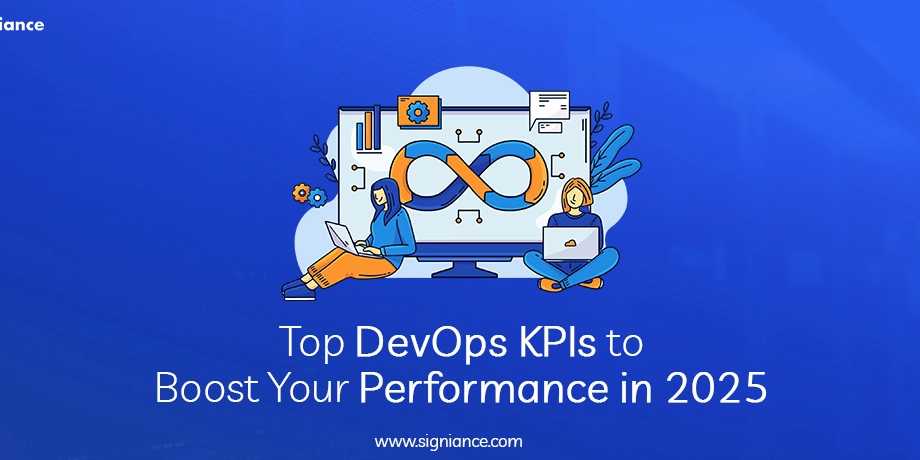These DevOps KPIs Will Boost Your Performance In 2025
As the DevOps landscape evolves, tracking the right KPIs (Key Performance Indicators) becomes more than a performance metric it becomes a strategy for continuous improvement, team alignment, and business value delivery. In 2025, DevOps is not just about shipping code faster. It's about delivering resilient, scalable, and secure systems while maintaining harmony across development and operations. Here’s a look at the most relevant KPIs DevOps teams should track in 2025 to ensure performance, productivity, and reliability are all on target. Deployment Frequency Why it matters: This KPI measures how often you deploy code to production. High-performing DevOps teams typically deploy multiple times per day. How to improve: •Automate CI/CD pipelines •Embrace feature flags and trunk-based development •Encourage smaller, incremental releases Pro tip: Pair this metric with Change Failure Rate to ensure quality isn't sacrificed for speed. Lead Time for Changes Definition: Time taken from code commit to production deployment. Why it’s critical: Shorter lead times indicate a healthy delivery pipeline, enabling quicker feedback loops and faster innovation. Tools to track: GitLab, CircleCI, Azure DevOps Goal for 2025: Aim for lead times under 1 day for high performing teams. Change Failure Rate (CFR) What it is: The percentage of deployments that result in degraded service or require a hotfix. Why it matters: A low CFR is a sign that your testing, automation, and review processes are robust. Reduce CFR by: •Enhancing pre-production testing •Improving code reviews •Using chaos engineering to identify vulnerabilities Mean Time to Recovery (MTTR) Definition: How long does it take your team to recover from a service interruption? Why this KPI matters: Downtime is inevitable, but how quickly you recover defines your reliability. Optimize by: •Automating incident response •Integrating observability tools like Datadog or Prometheus •Running regular disaster recovery drills System Uptime & Availability While not always in the spotlight of DevOps KPIs, system uptime is a business-critical metric. Track for: •SLA adherence •User satisfaction •Infrastructure resilience Leverage AWS CloudWatch or Azure Monitor for real time tracking. Developer Productivity In 2025, developer experience (DevEx) will drive productivity. Focus on qualitative and quantitative metrics like: •Time spent writing actual code vs. managing environments •Developer satisfaction surveys •Pull request throughput and cycle time Happy developers build better systems. Period. Infrastructure as Code (IaC) Coverage IaC tools like Terraform and AWS CloudFormation are the backbone of modern DevOps. Why track it? •More coverage = more repeatability and less human error •Aligns with compliance and security best practices KPI Suggestion: Track percentage of infrastructure provisioned through IaC. Security Scan Success Rate Shift left security means integrating scanning tools early in the pipeline. Monitor: •Percentage of successful security scans •Vulnerabilities fixed before deployment •Time to resolve critical CVEs Tip: Integrate tools like Snyk, Aqua, or AWS Inspector directly into your pipeline. Final Thoughts Tracking DevOps KPIs isn't about micromanaging teams it's about enabling them. As we move into 2025, data-backed decision-making will separate the average from the elite DevOps teams. Choose your KPIs carefully, align them with business goals, and continuously iterate based on insights. Measure what matters. Improve what you measure. And automate everything you can. Want to dive deeper? Check out the full article: Top DevOps KPIs to Boost Your Performance in 2025

As the DevOps landscape evolves, tracking the right KPIs (Key Performance Indicators) becomes more than a performance metric it becomes a strategy for continuous improvement, team alignment, and business value delivery.
In 2025, DevOps is not just about shipping code faster. It's about delivering resilient, scalable, and secure systems while maintaining harmony across development and operations.
Here’s a look at the most relevant KPIs DevOps teams should track in 2025 to ensure performance, productivity, and reliability are all on target.
- Deployment Frequency Why it matters: This KPI measures how often you deploy code to production. High-performing DevOps teams typically deploy multiple times per day. How to improve: •Automate CI/CD pipelines •Embrace feature flags and trunk-based development •Encourage smaller, incremental releases
Pro tip: Pair this metric with Change Failure Rate to ensure quality isn't sacrificed for speed.
Lead Time for Changes
Definition: Time taken from code commit to production deployment.
Why it’s critical: Shorter lead times indicate a healthy delivery pipeline, enabling quicker feedback loops and faster innovation.
Tools to track: GitLab, CircleCI, Azure DevOps
Goal for 2025: Aim for lead times under 1 day for high performing teams.Change Failure Rate (CFR)
What it is: The percentage of deployments that result in degraded service or require a hotfix.
Why it matters: A low CFR is a sign that your testing, automation, and review processes are robust.
Reduce CFR by:
•Enhancing pre-production testing
•Improving code reviews
•Using chaos engineering to identify vulnerabilitiesMean Time to Recovery (MTTR)
Definition: How long does it take your team to recover from a service interruption?
Why this KPI matters: Downtime is inevitable, but how quickly you recover defines your reliability.
Optimize by:
•Automating incident response
•Integrating observability tools like Datadog or Prometheus
•Running regular disaster recovery drillsSystem Uptime & Availability
While not always in the spotlight of DevOps KPIs, system uptime is a business-critical metric.
Track for:
•SLA adherence
•User satisfaction
•Infrastructure resilience
Leverage AWS CloudWatch or Azure Monitor for real time tracking.Developer Productivity
In 2025, developer experience (DevEx) will drive productivity. Focus on qualitative and quantitative metrics like:
•Time spent writing actual code vs. managing environments
•Developer satisfaction surveys
•Pull request throughput and cycle time
Happy developers build better systems. Period.Infrastructure as Code (IaC) Coverage
IaC tools like Terraform and AWS CloudFormation are the backbone of modern DevOps.
Why track it?
•More coverage = more repeatability and less human error
•Aligns with compliance and security best practices
KPI Suggestion: Track percentage of infrastructure provisioned through IaC.Security Scan Success Rate
Shift left security means integrating scanning tools early in the pipeline. Monitor:
•Percentage of successful security scans
•Vulnerabilities fixed before deployment
•Time to resolve critical CVEs
Tip: Integrate tools like Snyk, Aqua, or AWS Inspector directly into your pipeline.
Final Thoughts
Tracking DevOps KPIs isn't about micromanaging teams it's about enabling them. As we move into 2025, data-backed decision-making will separate the average from the elite DevOps teams.
Choose your KPIs carefully, align them with business goals, and continuously iterate based on insights.
Measure what matters. Improve what you measure. And automate everything you can.
Want to dive deeper?
Check out the full article: Top DevOps KPIs to Boost Your Performance in 2025








































































































































































![[The AI Show Episode 145]: OpenAI Releases o3 and o4-mini, AI Is Causing “Quiet Layoffs,” Executive Order on Youth AI Education & GPT-4o’s Controversial Update](https://www.marketingaiinstitute.com/hubfs/ep%20145%20cover.png)



























































































































































































































































































































































































![Apple Shares Official Teaser for 'Highest 2 Lowest' Starring Denzel Washington [Video]](https://www.iclarified.com/images/news/97221/97221/97221-640.jpg)

![Under-Display Face ID Coming to iPhone 18 Pro and Pro Max [Rumor]](https://www.iclarified.com/images/news/97215/97215/97215-640.jpg)

































































































